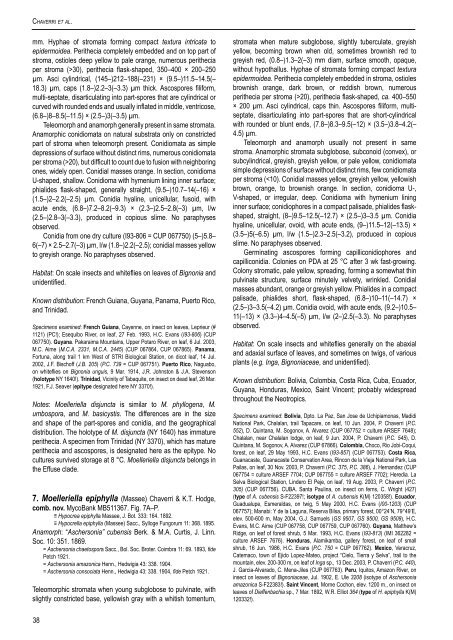Moelleriella, and Samuelsia - CBS
Moelleriella, and Samuelsia - CBS
Moelleriella, and Samuelsia - CBS
- No tags were found...
You also want an ePaper? Increase the reach of your titles
YUMPU automatically turns print PDFs into web optimized ePapers that Google loves.
Ch av e r r i e t a l.mm. Hyphae of stromata forming compact textura intricata toepidermoidea. Perithecia completely embedded <strong>and</strong> on top part ofstroma, ostioles deep yellow to pale orange, numerous peritheciaper stroma (>30), perithecia flask-shaped, 350–400 × 200–250µm. Asci cylindrical, (145–)212–188(–231) × (9.5–)11.5–14.5(–18.3) µm, caps (1.8–)2.2–3(–3.3) µm thick. Ascospores filiform,multi-septate, disarticulating into part-spores that are cylindrical orcurved with rounded ends <strong>and</strong> usually inflated in middle, ventricose,(6.8–)8–8.5(–11.5) × (2.5–)3(–3.5) µm.Teleomorph <strong>and</strong> anamorph generally present in same stromata.Anamorphic conidiomata on natural substrata only on constrictedpart of stroma when teleomorph present. Conidiomata as simpledepressions of surface without distinct rims, numerous conidiomataper stroma (>20), but difficult to count due to fusion with neighboringones, widely open. Conidial masses orange. In section, conidiomaU-shaped, shallow. Conidioma with hymenium lining inner surface;phialides flask-shaped, generally straight, (9.5–)10.7–14(–16) ×(1.5–)2–2.2(–2.5) µm. Conidia hyaline, unicellular, fusoid, withacute ends, (6.8–)7.2–8.2(–9.3) × (2.3–)2.5–2.8(–3) µm, l/w(2.5–)2.8–3(–3.3), produced in copious slime. No paraphysesobserved.Conidia from one dry culture (I93-806 = CUP 067750) (5–)5.8–6(–7) × 2.5–2.7(–3) µm, l/w (1.8–)2.2(–2.5); conidial masses yellowto greyish orange. No paraphyses observed.Habitat: On scale insects <strong>and</strong> whiteflies on leaves of Bignonia <strong>and</strong>unidentified.Known distribution: French Guiana, Guyana, Panama, Puerto Rico,<strong>and</strong> Trinidad.Specimens examined: French Guiana, Cayenne, on insect on leaves, Leprieur (#1121) (PC!); Esequibo River, on leaf, 27 Feb. 1993, H.C. Evans (I93-806) (CUP067750). Guyana. Pakaraima Mountains, Upper Potaro River, on leaf, 6 Jul. 2003,M.C. Aime (M.C.A. 2331, M.C.A. 2445) (CUP 067864, CUP 067865). Panama,Fortuna, along trail 1 km West of STRI Biological Station, on dicot leaf, 14 Jul.2002, J.F. Bischoff (J.B. 205) (P.C. 739 = CUP 067751). Puerto Rico, Naguabo,on whiteflies on Bignonia unguis, 9 Mar. 1914, J.R. Johnston & J.A. Stevenson(holotype NY 1640!). Trinidad, Vicinity of Tabaquite, on insect on dead leaf, 26 Mar.1921, F.J. Seaver (epitype designated here NY 3370!).Notes: <strong>Moelleriella</strong> disjuncta is similar to M. phyllogena, M.umbospora, <strong>and</strong> M. basicystis. The differences are in the size<strong>and</strong> shape of the part-spores <strong>and</strong> conidia, <strong>and</strong> the geographicaldistribution. The holotype of M. disjuncta (NY 1640) has immatureperithecia. A specimen from Trinidad (NY 3370), which has matureperithecia <strong>and</strong> ascospores, is designated here as the epitype. Nocultures survived storage at 8 °C. <strong>Moelleriella</strong> disjuncta belongs inthe Effuse clade.7. <strong>Moelleriella</strong> epiphylla (Massee) Chaverri & K.T. Hodge,comb. nov. MycoBank MB511367. Fig. 7A–P.≡ Hypocrea epiphylla Massee, J. Bot. 333: 164. 1892.≡ Hypocrella epiphylla (Massee) Sacc., Sylloge Fungorum 11: 368. 1895.Anamorph: “Aschersonia” cubensis Berk. & M.A. Curtis, J. Linn.Soc. 10: 351. 1869.= Aschersonia chaetospora Sacc., Bol. Soc. Broter. Coimbra 11: 69. 1893, fidePetch 1921.= Aschersonia amazonica Henn., Hedwigia 43: 338. 1904.= Aschersonia consociata Henn., Hedwigia 43: 338. 1904, fide Petch 1921.Teleomorphic stromata when young subglobose to pulvinate, withslightly constricted base, yellowish gray with a whitish tomentum,stromata when mature subglobose, slightly tuberculate, greyishyellow, becoming brown when old, sometimes brownish red togreyish red, (0.8–)1.3–2(–3) mm diam, surface smooth, opaque,without hypothallus. Hyphae of stromata forming compact texturaepidermoidea. Perithecia completely embedded in stroma, ostiolesbrownish orange, dark brown, or reddish brown, numerousperithecia per stroma (>20), perithecia flask-shaped, ca. 400–550× 200 µm. Asci cylindrical, caps thin. Ascospores filiform, multiseptate,disarticulating into part-spores that are short-cylindricalwith rounded or blunt ends, (7.8–)8.3–9.5(–12) × (3.5–)3.8–4.2(–4.5) µm.Teleomorph <strong>and</strong> anamorph usually not present in samestroma. Anamorphic stromata subglobose, subconoid (convex), orsubcylindrical, greyish, greyish yellow, or pale yellow, conidiomatasimple depressions of surface without distinct rims, few conidiomataper stroma (
















